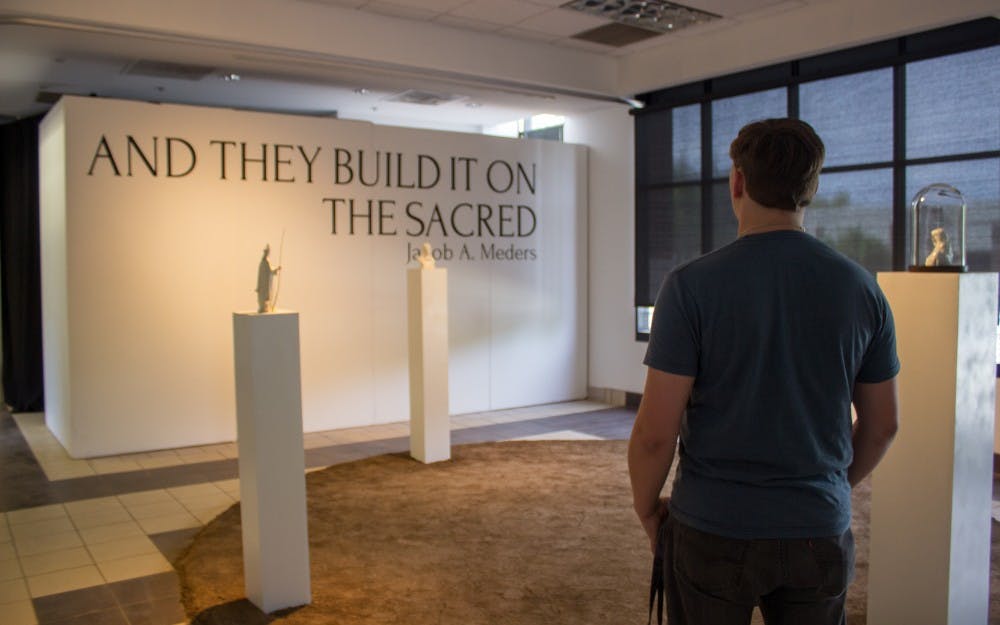Jacob Meders’ “And It’s Built on the Sacred” exhibit, hosted in the ArtSpace West gallery at ASU’s School of Humanities, Arts and Cultural Studies at the New College, hopes to engage viewers in a dialogue about the commodification and gentrification of indigenous land and culture by the U.S.
Meders, assistant professor at the School of Humanities, Arts and Cultural Studies and member of the Mechoopda tribe, said a primary focus of his show, which is on display through April 12, is reclaiming sacred symbols discarded by the U.S., both Native and Christian.
Effigies of important figures in Christianity with tribal markings across their faces and bodies stand on display at the four cardinal points of the exhibit. Meders said the markings may be found on a number of indigenous items such as dance regalia or baskets. Some, like the markings under the lip of a bust of the Virgin Mary, mirror tattoos worn by Native women to symbolize their social status, possibly as a mother or wife.
The effigies, found by Meders at places like Goodwill and other thrift stores, are meant to symbolize that which has been tossed aside by the West and, more specifically, Christianity.
“They’re unwanted, and I think that speaks a lot to the mindset in that belief system: that it’s okay to commercialize, it’s okay to commodify what is holy and what is sacred, and it’s okay to just discard that as well,” Meders said. “If it’s so easily done and so widely accepted in that faith to do that to things that mark the holy or the sacred, then, as indigenous people, how do we expect there to be any kind of understanding of protecting what is sacred to us and honoring what is sacred to us?”
The four sculptures sit atop pedestals placed on a circular platform of Earth taken from Meders’ own front yard. He says the dirt represents the circles involved in many Native rituals and ceremonies, such as meetings, dancing and prayer. It is also meant to be a source of direct involvement for gallery viewers, as they have to step up onto the dirt, and therefore into the sacred space Meders has created.
“Too often people are on the outside looking in on Native culture and Native ideas,” he said. “I’m inviting the viewer to step into that space.”
For viewers like Jose Suarez, ASU interdisciplinary arts and performance freshman and gallery employee, Meders’ assimilation of Christian iconography into Native culture makes the exhibition’s message that much stronger.
“I’ve always been taught by my parents that Jesus is always going to protect you, God is always going to protect you,” he said. “So, standing in the middle of the circle and looking around, I kind of get that sense.”
Meders said this is another key point of the gallery.
“If you use identifying aesthetics that non-Native people are familiar with, then it gives them something they can relate to within the work,” he said. “But there’s always enough of a twist that gives them the questions behind it that they need to seek.”
The messages in Meders’ exhibition are as relevant now as they were a few hundred years ago, as fights over resources like water and land remain a prevalent part of indigenous life.
“U.S. policy is to eradicate Native people,” he said. “There’s still an Indian War – it’s just done differently.”
Meders says the best thing non-Natives can do to help further the dialogue of his work is to educate themselves and be mindful of the stolen spaces that we inhabit. Even ASU, he said, stands on Native ground.
“Most Native communities don’t need non-Natives to come run out there and help them and rescue them – it’s not about that,” he said. “The first step is knowledge, understanding and respect, and when we do ask for help, we will tell you what we need your help for, as most people would.”
Meders said those looking to help Native communities within the Phoenix area are welcome to attend the Silver and Turquoise Ball fundraiser on April 14, for which he is an auction committee member.
Nick Mansell, an ASU alumnus who worked on graphic design for the exhibit, said he felt honored to work with Meders, who had been a mentor to him while he attended ASU.
“I’m very young in the art world, and I don’t have a lot of exposure, so being part of (the work of) an artist that does is pretty humbling and honoring,” he said.
Reach the reporter at mrobbin9@asu.edu or follow @MelissaARobbins on Twitter.
Like The State Press on Facebook and follow @statepress on Twitter.




